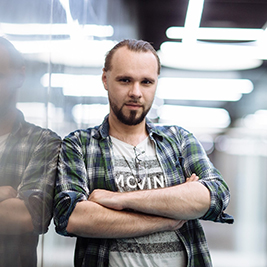Bank of Portraits / Matviyuk Vakula, Hanna and Lavrentiy

Matviyuk Vakula, Hanna and Lavrentiy
In the period of the German-Soviet war, helping the persecuted Jews meant mortal danger. One of those who dared to express his humanness in this way was Vakula Matviyuk. He lived with his large family in the village of Brody, Vohlynia. At the beginning of the war, the man was far older than 50 years old, so some of his children managed to create their own families. This notably increased the risk: if someone learned about Vakula and his wife Hanna helping the Jews, the entire large family would get under the danger. In spite of this, he sheltered Herzel Kaminetskyi, the blacksmith from the neighboring village of Hirnyky, in 1942.
Herzel and his family were among a handful of the Jews from Vohlynia, who were fortunate to survive the Holocaust. The German troops occupied this region in the very beginning of the German-Soviet war. The Jewish community immediately began to suffer persecution. The occupation authorities forced the Jews to register. They had to wear the special armband, later replaced by the patch with the yellow Star of David. The Jews were deprived of valuables and religious items. In the town of Ratne near Brody village, the German soldiers and collaborators from the auxiliary police shot dead 27 Jews few days after the seizure of the settlement.
However, the worst for the Jewish community of Vohlynia was later. In the cities and towns, the ghettos were established, where the Jews from the neighboring villages were forcibly relocated. The occupiers separated the qualified workers and work-capable. Rest of them were gradually exterminated. Under the conditions of hunger, diseases and despair, the prisoners expected to be taken by trucks to the previously prepared sites in the outskirts and executed.

The ghettos operated in the closest towns to the home village of Vakula Matviyuk, Ratne and Kamin-Kashyrskyi. Approximately 1,000 Jews from the Ratne ghetto were shot dead in the forest strip near the village of Prokhid.
Probably, Herzel Kaminetskyi with family could share their destiny, if Vakula did not offer him shelter. Matviyuk prepared the hideout in the shed for seven persons: Herzel, his wife Hasia, son Ben-Zion, grandchildren Velvel-Zeev and Leya, as well as elder daughter Udela with the husband Yakov Hohman.
For a long time, the Ukrainian and Jewish families lived together, facing difficulties, but with mutual understanding and support. Vakula and Herzel walked around the outskirts at night, knocking on the neighbors’ doors in search of food and other kinds of assistance. 13-year old Lavrentiy, son of Matviyuks, took care of Udela’s babies. Except this, the boy was a chain link who connected the escapees with the outer world, bringing them the latest news. Sometimes he even took them outside.
In the summer of 1943, Yakov risked leaving the hideout at night, but was caught and murdered. After this, the rumor spread about the Jews hiding in the village of Brody. Shortly after that, the unit of the Ukrainian partisans came to the house of Matviyuks. They found the Kaminetsky family and took them to the unit. The lives of the Jews were saved under conditions that Herzel would work for the underground.
Until the summer of 1944, the Kaminetsky family was kept in the Richytsia village. Shortly before the retreat of the German troops they escaped and hid among the Soviet partisans for some period of time.
In the end of the 1940s, Herzel and his family migrated to Israel, but exchanged letters with the Matviyuk family.
On July 7, 1996, Vakula Matviyuk, his wife Hanna and son Lavrentiy were honored as the Righteous Among the Nations.

Maksym Milevskyi
Kyiv
The National Museum of the History of Ukraine in the Second World War
-
fingerprintArtefacts
-
theatersVideo
-
subjectLibrary

